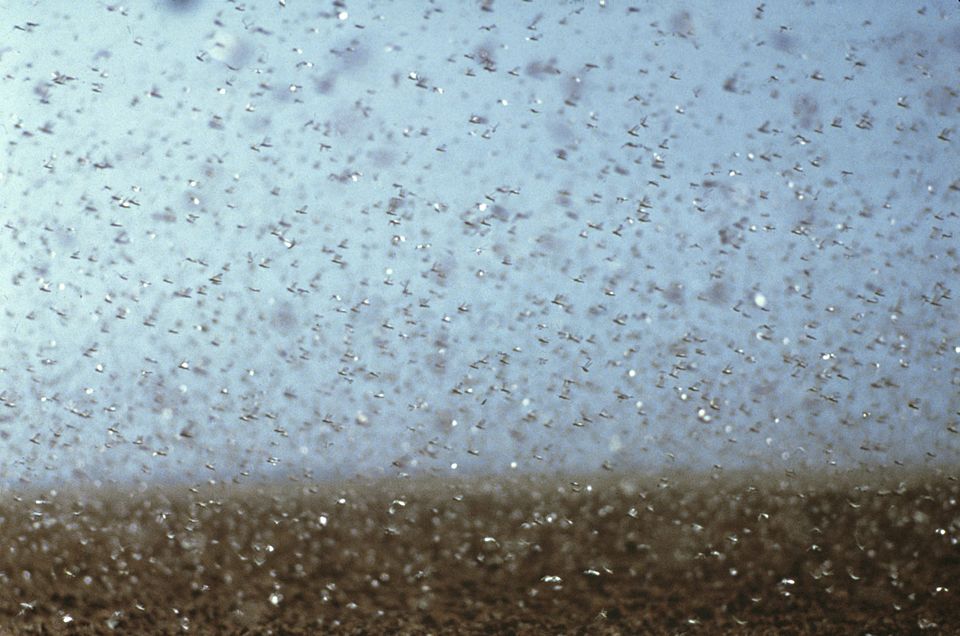
Why do locusts swarm? Locusts swarm because they come into contact with other locusts. This seems like a chicken and an egg problem. Locusts swarm because they come into contact with other locusts, and they come into contact with other locusts because they swarm.
A locust swarm can be a terrible sight to behold. There is a good reason why one of the ten plagues in the Bible was a plague of locusts. A swarm of locusts can spread over hundreds of square kilometers, potentially even thousands of square kilometers, and there can be hundreds of millions of locusts per square kilometer. That can lead to swarms of hundreds of billions of locusts. The locust in these swarms is usually a desert locust, and they weigh about 2 grams. Each locust is capable of eating its own weight in plant matter every day, which means the largest locust swarms can eat roughly 200,000 tons of plant matter every single day. They can devastate the land and eat everything in sight. Then, when they have consumed everything, they move on. Swarms of locusts can be a cause of poverty and famine in poorer countries, unless they can be controlled.
A locus is a type of grasshopper, and the name locus comes from the Latin locusta, which means lobster. I’m not sure why. There are several types of locusts that form swarms, but the desert locust is probably the most common. They mostly live in the deserts of northern and eastern Africa and southwest Asia. The males are about 6 cm long and the females can be 9 cm long. The females are adapted to producing eggs, which requires more energy. On average, they weigh about 2 grams. They are grasshoppers, so they share the jumping ability, and they also have wings. Locusts are generally solitary insects, and they don’t like to get close to other locusts. So, if they don’t like being close to other locusts, why do they start to swarm in their billions?
Locusts swarm because they undergo a physical change from solitary locusts to gregarious locusts. Generally, they are shy, solitary, pale green or pale yellow locusts. When they change, they become gregarious, social, yellow and black striped locusts. It is an actual physical change. This is why swarms are not constant and some years have swarms while other years don’t.
The transformation from solitary locusts to gregarious locusts is caused by physical contact with other locusts. Generally, there is not enough food to support a large population of locusts, and they can spread out without coming into contact with each other. In some years, there is more rain than in other years, and when that happens, vegetation starts to grow. More plants mean more food, which means more locusts. As the number of locusts increases, they start to come into contact with each other. Every time their hind legs come into contact with another locust, serotonin is released in their brains. In our brains, serotonin regulates our moods, our sleep, our appetite, and many other things. In locusts, increased serotonin tells them to change color, eat more, and mate more. They stop being solitary insects and form massive groups of flying locusts, eating everything they can find and rapidly multiplying. And any other locusts they come across undergo the same change and get picked up by the swarm. It is a bit like the dust storms in the USA. They pick up material and make themselves larger, which means they pick up more material.
These locust swarms will eventually disappear once they have eaten all of the food, but that can be devastating for the people who live in those areas. Locust swarms can cause famine. A locust swarm is very hard to stop because they are spread over such a large area and because the places they affect often don’t have the resources. There are chemical insecticides, but they are very strong and they can do a lot of damage to the plants and the people. Another technique for controlling them is with fungal spores. There is a fungus called Metarhizium acridum, which can kill locusts. Dried spores of the fungus are sprayed over the locust swarm, and they germinate inside the locusts, killing them. This seems to be the best way because it kills the locusts without harming any other animal.
Catching these locust swarms for food is another possibility. As it becomes harder for us to grow our food, we may have to turn to eating insects. Locusts are plentiful, and they contain a lot of nutrients and protein. Most people wouldn’t want to eat a locust, but if they were ground down into a flour to make bread, you would never really know. And this is what I learned today.
Read the first 6 volumes on kindle: https://mybook.to/125questions6books
Sources
https://en.wikipedia.org/wiki/Desert_locust
https://www.sciencefocus.com/nature/why-do-locusts-swarm
https://en.wikipedia.org/wiki/Locust
https://www.ab.mpg.de/389304/Collective-behavior-in-locust-swarms
https://www.etymonline.com/search?q=locust
Image By CSIRO, CC BY 3.0, https://commons.wikimedia.org/w/index.php?curid=35486123
